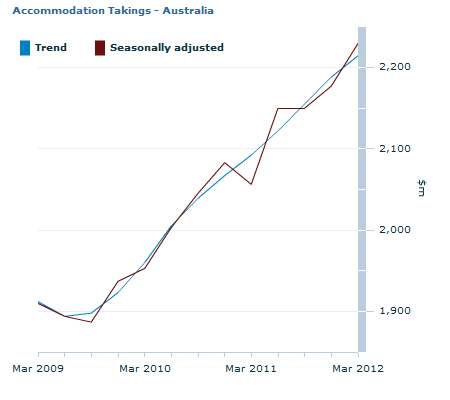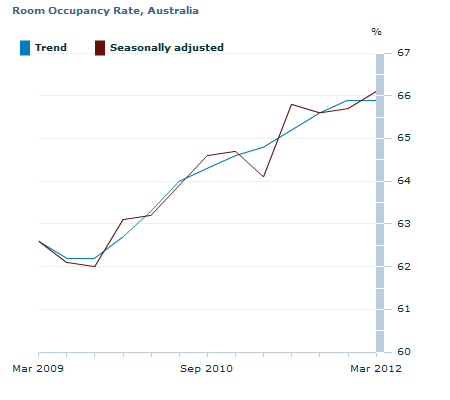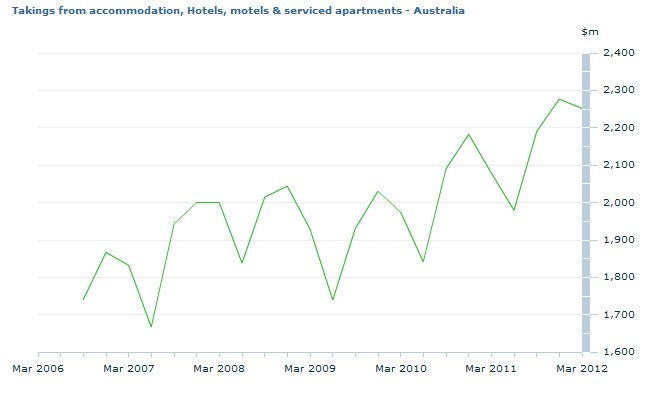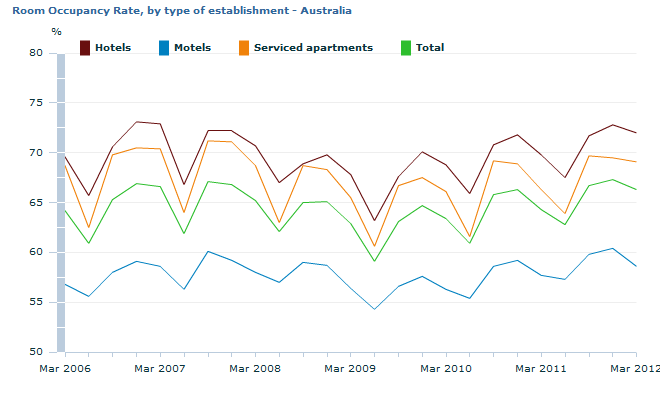8635.0 - Tourist Accommodation, Australia, Mar 2012  Quality Declaration
Quality Declaration
ARCHIVED ISSUE Released at 11:30 AM (CANBERRA TIME) 29/06/2012
Page tools:
 Print Page Print Page
 Print All Print All
| ||||||||||||||||||||||||||||||||||||||||||||||||||||||||||||||||||||
|
MARCH KEY FIGURES
MARCH KEY POINTS ACCOMMODATION TAKINGS
ROOM OCCUPANCY RATE
NOTES FORTHCOMING ISSUES
ABOUT THIS ISSUE This issue presents results from the March quarter 2012 Survey of Tourist Accommodation (STA) for the following categories of establishments:
CHANGES TO THIS PUBLICATION The PDF component of this product has been discontinued. Individual tables that were previously included in the PDF publication are available as a data cube on the Downloads page. GEOGRAPHY CHANGES The March quarter 2012 release of STA data is the first to incorporate the Australian Statistical Geography Standard (ASGS) as the geographical framework for the collection. Detailed information on the transition of the STA to the ASGS and how the data is impacted by this change is contained in Information Paper: Future Changes to Tourist Accommodation, Australia (cat. no. 8635.0.55.003) A summary of the main changes resulting from the move to ASGS are:
STAR RATING AAA Tourism manages the scheme that applies STAR Ratings to accommodation establishments. This scheme has undergone a strategic review resulting in changes to the application of STAR Ratings. The changes to STAR Rating will be introduced to the STA collection over the coming quarters. Further enquiries on changes to the STAR Rating system should be directed to stars@aaatourism.com.au. INQUIRIES For further information about these and related statistics, contact the National Information and Referral Service on 1300 135 070. SUMMARY COMMENTARY ORIGINAL Hotels, motels and serviced apartments This summary contains key findings for original estimates. Original series are impacted by seasonal variations and irregular or non-seasonal influences. Comparison between quarters should be made with caution. Accommodation takings In the March quarter 2012, accommodation takings were $2252.0 million for hotels, motels and serviced apartments with 15 or more rooms. Accommodation takings in the March quarter 2012 for hotels, motels and serviced apartments with 15 or more rooms were highest in New South Wales ($733.6 million) and Queensland ($529.7 million). The Northern Territory recorded the lowest takings for the period ($45.2 million). For Australia, the March quarter 2012 average takings per room night occupied were $164.87 for establishments with 15 or more rooms. This was 3.2% higher than the March quarter 2011 ($159.76). Room occupancy rate The room occupancy rate for hotels, motels and serviced apartments with 15 or more rooms was 66.3% in the March quarter 2012. Traditionally, hotels have higher occupancy rates than motels or serviced apartments. Over the March 2012 quarter, hotels had an occupancy rate of 72.0% compared with 58.6% for motels and 69.1% for serviced apartments. Six out of the eight states and territories experienced an increase in the occupancy rate of hotels, motels and serviced apartments with 15 or more rooms between the March quarter 2011 and the March quarter 2012. Queensland (62.3%) experienced the largest increase (4.2 percentage points). Over the same period, occupancy in Tasmania (71.4%) decreased by 1.1 percentage points. The Australian Capital Territory recorded the highest occupancy rate (73.6%) in the March quarter 2012 followed by Tasmania (71.4%) and Western Australia (70.2%). Over the same period, the Northern Territory experienced the lowest occupancy rate (53.1%). Room nights Occupied Room nights occupied were 13.7 million in the March quarter 2012 for hotels, motels and serviced apartments with 15 or more rooms. New South Wales contributed the largest proportion (31.5%) of room nights occupied for hotels, motels and serviced apartments with 15 or more rooms, followed by Queensland (25.4%). Average Length of Stay The average length of stay over the March quarter 2012 for hotels, motels and serviced apartments with 15 or more rooms was 2.3 days. Queensland reported the longest average length of stay (2.8 days) followed by Western Australia (2.6 days). Tasmania had the shortest average length of stay (2.0 days). Document Selection These documents will be presented in a new window.
|
|||||||||||||||||||||||||||||||||||||||||||||||||||||||||||||||||||




, by type of establishment - Australia.gif)
